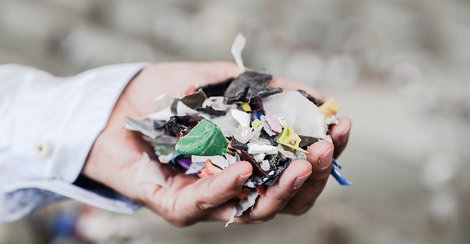The Great Snippet Hunt
In Herbolzheim, we have built one of the most modern recycling plants in the world. Recycling is very important here. Millions of yoghurt pots and other plastic waste are turned into valuable raw materials. These are then processed into our products and climate solutions. More sustainability is hardly possible... In the following report, we take you on a tour of the plant.
From household waste to plastic shreds
Not all plastic is the same - "you need to know that before you can understand this," Jörg Drägert, our Head of Raw Materials Management, tells us right at the start.
We are curious from the very first moment - and amazed: where is the waste that is recycled here and from which new environmental products are later created? You can't see or smell it ...
"There it is," says Jörg Drägert with a grin. He points into a ravine of concrete walls, where there are indeed piles of colorful scraps several meters high. But it doesn't look like garbage, more like the treasure trove of the assembled carnival clubs, of which there are plenty here in South Baden. Confetti for the next wild days. "And it doesn't stink because the snippets have already been cleaned several times," the expert continues.

If you like, we have just arrived in our hallowed halls. In our heart, which only opened in 2020, we obtain the raw material for our products - ordinary household waste, packaging such as yogurt pots, shampoo bottles or chip bags become our recyclate. More than 70 percent of our product range is already made from these materials. And the trend is rising.
Jörg Drägert leads us further into the impressive hall. We follow the shreds, so to speak, even if we only see them briefly every now and then, for example when they shoot over the conveyor belts or there are peepholes on the machines. Otherwise, they are transported from station to station using an ingenious system. The halls themselves are spotlessly clean. Not a scrap flies around. And we still can't smell anything ...
Plastic separation in the sorting plant
"We use a wide variety of systems here to separate and sort the plastics," explains our raw materials manager. We are looking for polyethylenes (PE) and polypropylenes (PP) - both high-quality plastics that do not react with other materials and can also be easily recycled later. "We obtain them using a wide variety of methods, such as optical features with high-tech cameras and infrared systems," says our guide. Exciting! "How many of these stations are there here?" we want to know straight away. "More than 20, each worth 300,000 euros," says Drägert.

Of course, such a complex system was not created overnight. Long before the first sod was turned here on the site in Herbolzheim, our engineers at the headquarters in Teningen had spent many years developing the entire process in a test facility. We have worked hard to gain this innovative edge; the technology is unique worldwide. "Thousands of hours of work have gone into it. But seeing how it all works here on a large scale is a wonderful feeling," says the raw materials manager. It's a bit like watching your own baby learn to walk ...
Processing into granulate
A few machines down the line on our tour, it starts to smell a bit like candles going out. And indeed, we have arrived at the end of the sorting plant. From here, the shredded plastic shreds are melted and processed into granulate. A large proportion of this goes into the huge silver silos directly in front of the plant. Trucks load the material from these silos and transport it to the other production sites in the region. To Teningen and Neuried as well as Dachstein in Alsace. Not far away. Some of the material is already being reused on site. An EcoBloc infiltration trench has just come out of the machine, which is used to infiltrate and retain rainwater. Just yoghurt pots - and shortly afterwards a freshly baked, intelligent climate protection solution. If that doesn't smell like the future ..




